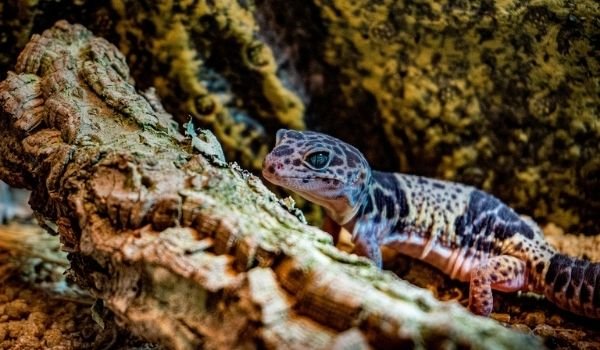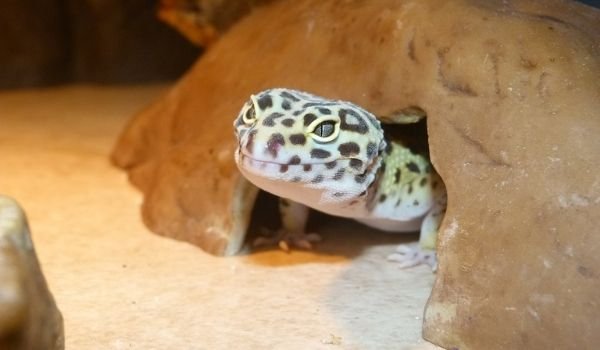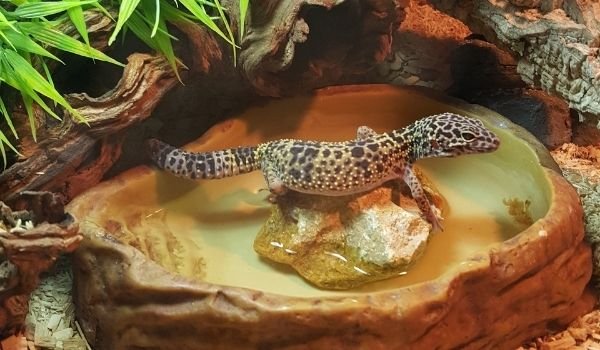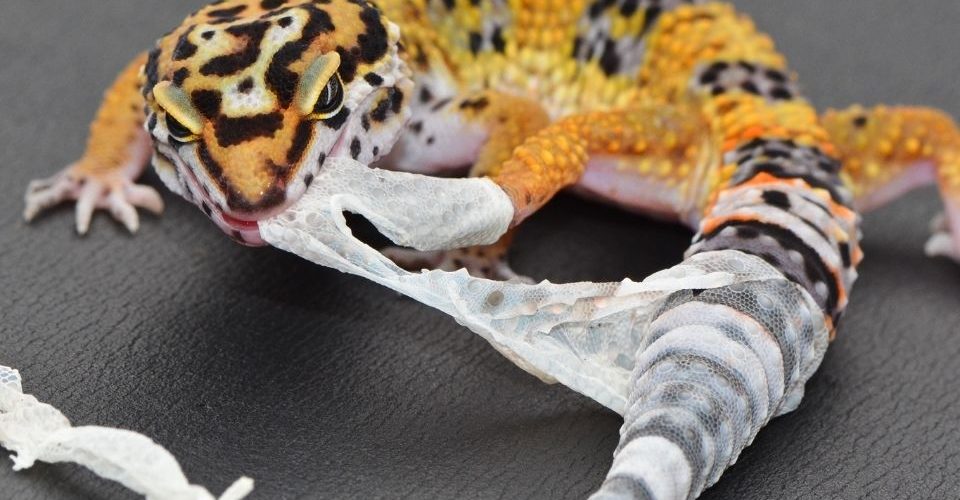Though shedding in reptiles is a natural and healthy process, watching your favorite pet lose its skin is sometimes worrisome. We are afraid that our Leopard gecko might develop some complications during the shedding process. While in their natural habitat, Leopard geckos experience little to no problem in their shedding process; in captivity, however, if the Leopard gecko care is not up to mark, they may experience difficulty shedding their skin.
Here is a guide on Leopard gecko shedding that will throw light on all of the important aspects of the gecko shedding process: How often do Leopard geckos shed? How to help Leopard gecko shed? Do Leopard geckos eat their shed?
We will also discuss the most common Leopard gecko shedding problems and their solutions. It will also discuss some other common questions gecko owners have on their minds. Just keep on reading to familiarize yourself with the Leopard gecko shedding process so that you are better equipped to facilitate your Leopard gecko shed the next time.
Leopard Gecko Shedding
Leopard gecko shedding is a normal and healthy process, and most of the Leopard geckos do not experience any complications during the shedding process if the optimum environment is maintained in the Leopard gecko tank.

How Often Do Leopard Geckos Shed?
Leopard geckos shed throughout their lifetime, and the shedding frequency is inversely proportional to their age. Hence, the recurrence of shedding in Leopard geckos depends entirely on their level of growth. This means that younger Leopard geckos will be shedding their skin more often as compared to adult geckos who have stopped growing after reaching adulthood.
There is no particular season for Leopard geckos to shed. However, the shedding frequency can be affected due to different reasons, such as brumation.
The frequency of Leopard gecko shedding in different age groups is summed up in the table below:
| Age (months) | Frequency |
| Up to Three | Every week or 2 |
| Three to Six | Every 2 or 3 week |
| Six to 18 | every 4 or 5 week |
| After 18 | Every 4 to 8 weeks |
Why Do Leopard Geckos Shed?
The answer is simple: they shed to grow new skin. Owing to the inelasticity of their epidermis, as their size increases with age, they do not fit in their old, non-stretchable skin and need to grow a new one to accommodate their growing bodies. Hence, they must grow new skin. This is also the reason why the young Leopard geckos shed more often as compared to adults.
Besides growing new and roomier skin, it can also benefit them in numerous ways. Due to the benefits of shedding, geckos do not stop shedding even after attaining their maximum size at around 18 months of age. However, there are some periods when Leopard geckos do not shed, for example, while incubating eggs.
Leopard Gecko Shedding Benefits
- It freshens the skin cells
- They can generate a new skin color
- It heals the skin injuries, if any
- It helps get rid of harmful parasites attached to the skin.
How Do Leopard Geckos Shed?
Leopard geckos have two layers of skin: an outer layer called the epidermis and an inner layer called the dermis. The epidermis is formed of keratin and is shed throughout their lifetime. And dermis has pigment-producing cells that impart beautiful colors of Leopard gecko morphs. This inner layer also contains a large number of blood vessels.
Geckos don’t shed their whole skin in one piece like snakes and some other lizards; rather, gecko skin is shed in patches.
They may use their teeth (yes, Leopard geckos have teeth—around 100) to pull off stubborn pieces of skin. They can do this job pretty easily; nevertheless, like us human beings, there are places where their teeth cannot reach. To peel the skin off such areas, they rub themselves against different surfaces until they get rid of the skin completely.
How Long Does the Leopard Gecko Shedding Process Take?
Regardless of their age, Leopard geckos take around 24 to 48 hours to completely shed their skin and grow new skin. If a raised humidity level is maintained in the tank, the shedding process is completed seamlessly and earlier.
Leopard Gecko Shedding Signs
Just before the shedding is about to take place in Leopard geckos, you might observe the following signs and symptoms, both physical and behavioral.
Dull Color
The color of Leopard gecko skin fades a week before they start shedding. Fluid is produced between the outer and the inner skin layers, which helps detach the former from the body, and the nutrient in it get absorbed—making Leopard geckos look dim in color.
Removing Skin
As the phase discussed above passes, Leopard geckos try to get rid of their pale skin either by rubbing themselves against different objects or by pulling it off with their teeth.
The Appearance of Brighter Skin
As Leopard geckos begin removing their skin by employing different methods, you will be able to spot new patches of brighter skin—eventually, your gecko will have completely new skin from head to tail.
Disinterest in Food
Leopard geckos are usually not into eating when they are shedding. Their eating patterns may change. Pet owners should never forcefully feed their Leopard geckos when they are about to shed.
Inactivity
Most Leopard geckos become lethargic when they are about to shed. It seems like they have lost interest in almost everything—they are not eating and are easily irritated by touches.
How to Facilitate Leopard Gecko Shedding?
In addition to providing the routine Leopard gecko care, Leopard gecko shedding can be made easier by ensuring the following provisions.
Humidity
To keep your Leopard gecko happy and healthy, you should maintain your Leopard Gecko tank humidity from 30% to 40%. Leopard geckos require at least 30% relative humidity level to shed effectively, and it becomes easier for them if the level hits 40%. As low humidity dries out the skin, making it difficult to be peeled, a good hygrometer can monitor if the pet geckos are getting an appropriate humidity level in the tank.

|
Providing a humid hide can also work wonders, especially when it is not possible to maintain the humidity level in the whole tank. Coconut fiber or sphagnum moss can keep the humidity level of the humid hide from 70% to 80%.

Misting
Misting (spraying lukewarm water) can help Leopard geckos in dropping their skin. It is recommended to mist the pet Leopard geckos when the signs of shedding become obvious. However, misting will not be necessary if the proper humidity levels are maintained.
Diet
The deficiency of vitamin A can lead to improper shedding in Leopard geckos. Similarly, a lack of water intake also affects the shedding process negatively. Pet owners should make sure that their Leopard geckos have access to these vital diet components, especially when they are about to shed. Multivitamin supplements can be of great utility here.

|
Nevertheless, Leopard geckos should not be fed more than enough water and vitamin A as the excess quantity can lead to other complications.

Rough Items
As discussed above, Leopard geckos tend to rub themselves against rough surfaces when they shed. Hence, providing such things, for example, rocks, can make it easy to get rid of old skin. But never provide them anything so rough that may cause a skin injury.
Leopard Gecko Shedding Problems and Solutions
While most Leopard geckos experience no trouble shedding throughout their lifetime, some may experience different shedding problems.
Patches of Stuck Skin
Skin shed can get stuck on Leopard geckos due to a variety of reasons. The most common are improper humidity and temperature, parasites, and other health problems. However, it can also be caused due to dietary problems; as already discussed, the deficiency of vitamin A can lead to shedding problems and can result in patches of retained skin.
There are some areas over the body which are more prone to this abnormality. They include the region around the eyes, the tail tip, the vicinity of the vents, and near the toes.
Toe loss in Geckos Due to Stuck Skin
Stuck skin around tiny toes of Leopard geckos blocks the blood supply to respective toes, which leads to the death of the toe. The dead toe eventually falls off. If still left untreated, it may lead to the development of a fatal infection.
Stuck shedding should be taken care of as it can cause limb loss or infections. Hence, it is important to inspect the whole body of pet Leopard geckos for any sign of retained skin after the completion of each shedding cycle.
Stuck skin should not be a problem to remove manually. Rubbing the area with a wet paper towel or a fine cloth can help it come off in a matter of minutes. However, one needs to rub the pets very gently so that they do not get hurt and become annoyed by touches or fondling—in which case Leopard gecko may bite you, suspecting you as a threat. Extra care should be taken for sensitive areas such as vents. Nevertheless, if the attempts remain unsuccessful, vet assistance should be sought immediately.
Increased or Decreased Leopard Gecko Shedding Frequency
Irregularity in shedding patterns in Leopard geckos can occur due to several reasons. Some of them are:
- Dehydration: It is among the most common causes. The skin becomes dry and, thus, harder to remove.
- Parasites: Shedding problems may be the secondary effect of parasitic infections in Leopard geckos. For instance, parasites can deprive their body of essential nutrients, leading to shedding irregularities.
- Burns: Burns usually result in excess shedding to expedite the healing process. Hot Rocks and heating mats could be responsible for causing burns in geckos.
- The Lack of Humidity: Below 30% humidity levels can lead to shedding abnormalities.
- Stress: Being under stress can make Leopard geckos eat less—causing the same problem as in parasitic infection. Handling Leopard geckos too much can give them mental stress. Keeping them with violent geckos can also lead to mental stress.
- Malnutrition: The lack of correct diet is among the basic causes of shedding abnormalities in Leopard geckos.
If you are providing a properly maintained environment—best lightning setup, best gecko substrate, optimum temperature and humidity—and balanced diet to your Leopard gecko, it should not experience any shedding problems. However, if it does experience trouble shedding, you should contact your vet.
Why Do Leopard Geckos Eat Their Shed?
Leopard geckos expend a lot of energy in shedding older skin and generating new skin, and thus they often eat the shed skin to make up for the expended nutrients.
So there is nothing to worry about if Leopard geckos eat their shed. In fact, there are several benefits associated with Leopard geckos eating their shed skin. First, they reabsorb the lost nutrients by eating the shed skin. Second, they keep the tank clean by removing their waste skin. Last but not least, they remove the signs of their presence to ward off the predators.
Leopard geckos usually stop eating as they prepare for the shedding process. Having nutrient-rich skin as their first meal right after shedding is a great kick-start.
FAQs
Should I Feed My Leopard Gecko While It’s Shedding?
No, you should not be feeding your Leopard gecko during the shedding process. Leopard geckos are lethargic and disinterested in food when preparing themselves for shedding. Therefore, there is no point in throwing insects in their tank for them to eat. Besides, live insects like crickets can also be irritating to their skin.
Therefore, you should avoid feeding your Leopard gecko while it sheds. It will be completely normal because they usually eat every two to four days, and the shedding process will be completed well before it’s time to feed your Leo. Moreover, Leopard geckos can go around 10 t0 14 days without food, so you don’t have to worry about your gecko not eating.
Can I Hold My Leopard Gecko While He Sheds?
No! Though Leopard geckos are quite fond of handling, their skin becomes extremely sensitive when they are shedding. Hence, they detest touching as even a placid touch could be hurtful to them. Because of the extra sensitivity of their skin during the shedding process, geckos become a bit aggressive and are more prone to biting the handler.
You can touch and handle your Leopard after the completion of its shedding process. However, if you have been touching it during the shedding process despite his aggression, it may take some time to get comfortable with your touch.
Should I Be Worried About Leopard Gecko Shedding?
No. You should not be worried about your Leopard gecko shedding as shedding in reptiles is completely normal and natural, as long as you maintain the optimum conditions in his tank and provide him with an appropriate Leopard Gecko diet. Nevertheless, if there occurs any complication again, you should seek medical help.
Conclusion
It is all right for Leopard geckos to shed. In fact, it is necessary for them to shed their old skin and grow new skin as they grow. Hence, they keep shedding in regular intervals of time—while juvenile Leopard geckos shed more often as they are growing, adult geckos shed every 4 to 8 weeks. There are certain measures pet owners can take to ensure the smooth and healthy Leopard gecko shedding process. Moreover, they should also be wary of the complications that may occur and, consequently, the ways to overcome them.





